 WEATHER
WEATHERClimate behaviour is described during the wheat campaign 2010-2011 resorting, once again, to the utilization of a method to calculate the water reserves in the soil and its abnormalities. The latter ones called “Classification of soil moisture” were calculated as a monthly average during the whole wheat cycle, although they come from a daily analysis and express the degree of deviation from the habitual conditions in each region and season. Moisture classification is an adequate climatic indicator since it summarizes the behaviour of most relevant climatic variables, such as spatial and temporal distribution of precipitation and its interaction with evapotranspiration which at the same time depends on room temperature, solar radiation, wind and atmospheric humidity.
The maps, which are used in an operational way and for any period of time, are in this case monthly and contain a political subdivision by departments which can be associated to the known wheat zones of the country representing only the pampas provinces. The reader can have a clear idea of the climatic evolution of the wheat campaign through the sequence of maps of soil moisture classification and the description of its behaviour, since the agronomic considerations are described in another section of this publication. It is important to highlight that not always the habitual or normal conditions are the most adequate for the crop in all the regions and seasons; therefore in winter and early spring, normal conditions could result in hydric deficit in regions located towards the west or northwest of the area like the North V wheat region, while the same conditions could represent water excess in the soil towards the central east and west of the wheat region.
 MAY 2010
MAY 2010
At the beginning of the wheat campaign there was a less deficient panorama than in the previous year with reference to the availability of edaphic moisture, although the southern extreme of Cordoba province and its surrounding areas showed strong signs of drought. Towards the end of the month, excessive rainfalls affected Entre Rios province where early sowings delayed by the lack of water had to be delayed again due to soft soil. There was a strip in the centre of Cordoba province and northeast of Santa Fe province with almost normal conditions.
 JUNE 2010
JUNE 2010
Drought area was kept unchanged in the south of Cordoba where the optimal time for sowings had already been gone; this condition was extended with less intensity to the rest of the southeast of pampeana region where there was mainly a lack of superficial moisture for sowings. Conditions of edaphic moisture improved in most of the rest of wheat region although in Entre Rios province the excessively wet soil delayed or made early sowings difficult. The areas most affected by drought were sub regions V North and V South, except a central strip in Cordoba. In the north of Cordoba province, conditions were unfavourable like in the previous year.
 JULY 2010
JULY 2010
There was little variation in the conditions regarding the previous month. Strong deficit continued in the south of Cordoba province and its surrounding areas. There was also a strong lack of water in San Luis, La Pampa and north of Cordoba. Good conditions were present in the centre-east of Buenos Aires, Entre Rios and the above mentioned strip in Cordoba. Drier conditions started to be predominant in Santa Fe province but still acceptable.
 AUGUST 2010
AUGUST 2010
Hydric negative anomaly continued to intensify in the centre-west of pampeana region with its core in the south of Cordoba and surrounding areas, while in Entre Rios excess of water continued in an intermittent manner which made sowings be extended to the end of the month. This negative anomaly was also extended to most of Santa Fe province; however, the situation for wheat was still acceptable. There was a good condition in the north and southeast of Buenos Aires. In the driest areas of the west and mainly northeast of the region, the first drying winds arrived, as it is usual for this season and which in turn are so unfavourable for wheat crops.
 SEPTEMBER 2010
SEPTEMBER 2010
The most important aspect was the hydric improvement of the soils towards the west of the region, mainly to the east of La Pampa. This improvement was later extended to the south of Cordoba and although it did not reach normal values in edaphic moisture, previous situation was greatly improved at a critical moment for crops so that those carried out on fallow periods may have reacted favourably, though deficiencies continued in the north of Cordoba and southwest of pampeana region in general. In the east of the wheat region, excellent conditions continued for winter crops which promised good yields, although there were zones with excess of moisture.
 OCTOBER 2010
OCTOBER 2010
The great improvement in water conditions in September in the dry areas of the west of Pampeana region, determined that La Pampa and west of Buenos Aires province were first benefited and then great part of Cordoba. The wheat of La Pampa improved its condition considerably, for the wheat in the centre-west of Cordoba these rains could have been convenient if there had not existed the strong deficit since the fall which avoided in many cases to make the sowings concreted. In the rest of the region the wheat panorama was good, in the southeast water was enough to address the period with greater demands in that region despite mild negative anomalies in the water, the same happened in other zones in the east of the region.
 NOVEMBER 2010
NOVEMBER 2010
The retreat in hydric conditions in most of the studied regions in the last two months did not affect planted wheat which had enough reserves for the last stage of its cycle so that a normal to good harvest was expected, having the possibility to be very good to the southeast of Buenos Aires, the last to be harvested and which continued to having excellent water reserves in the soil, abundant for the most demanding stages in this zone.
 DECEMBER 2010
DECEMBER 2010
As a month of harvest, in the centre and north of the region, negative anomalies in soil moisture are usually favourable for wheat. There were only positive anomalies in the centre-southeast of Buenos Aires, the only zone that could have benefited from this hydric boom in its last stages. In Río Cuarto zone, mild positive anomalies in an area of abundant rain falls in this period of the year would not damage the harvest by strong evapotranspiration of the season.
 JANUARY 2011
JANUARY 2011
The map of average hydric situation is added for this month since it is still a period for harvest in the southeast end of the wheat area. However, excessive soil moisture for the area and the season affected only the southwest zone and its surroundings where harvesting had already taken place, becoming difficult due to weeding in the eastern part of this region. In the southeast the situation was almost normal favouring the last harvests.
| MAY 2010 | JUNE 2010 | JULY 2010 |
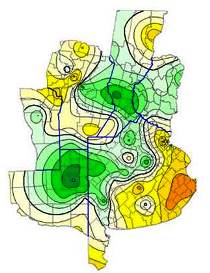
|
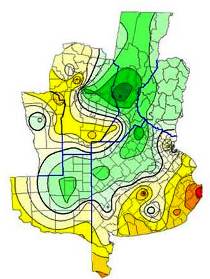
|
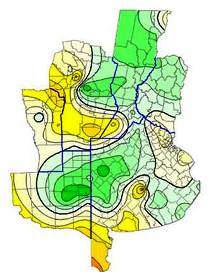
|
| AUGUST 2010 | SEPTEMBER 2010 | OCTOBER 2010 |
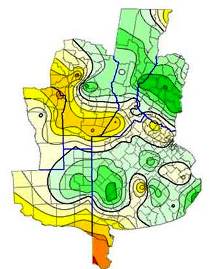
|
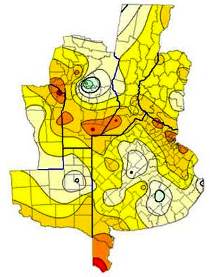
|
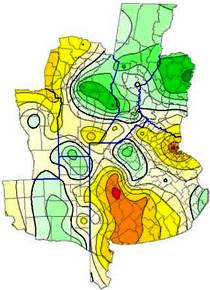
|
| NOVEMBER 2010 | DECEMBER 2010 | JANUARY 2011 |
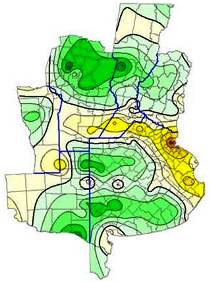
|
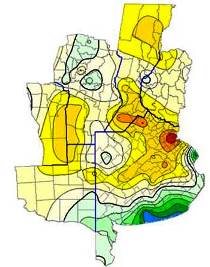
|
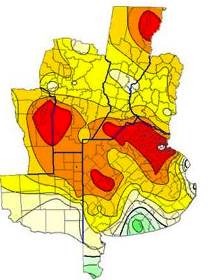
|
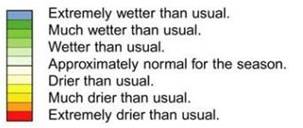
| ||







